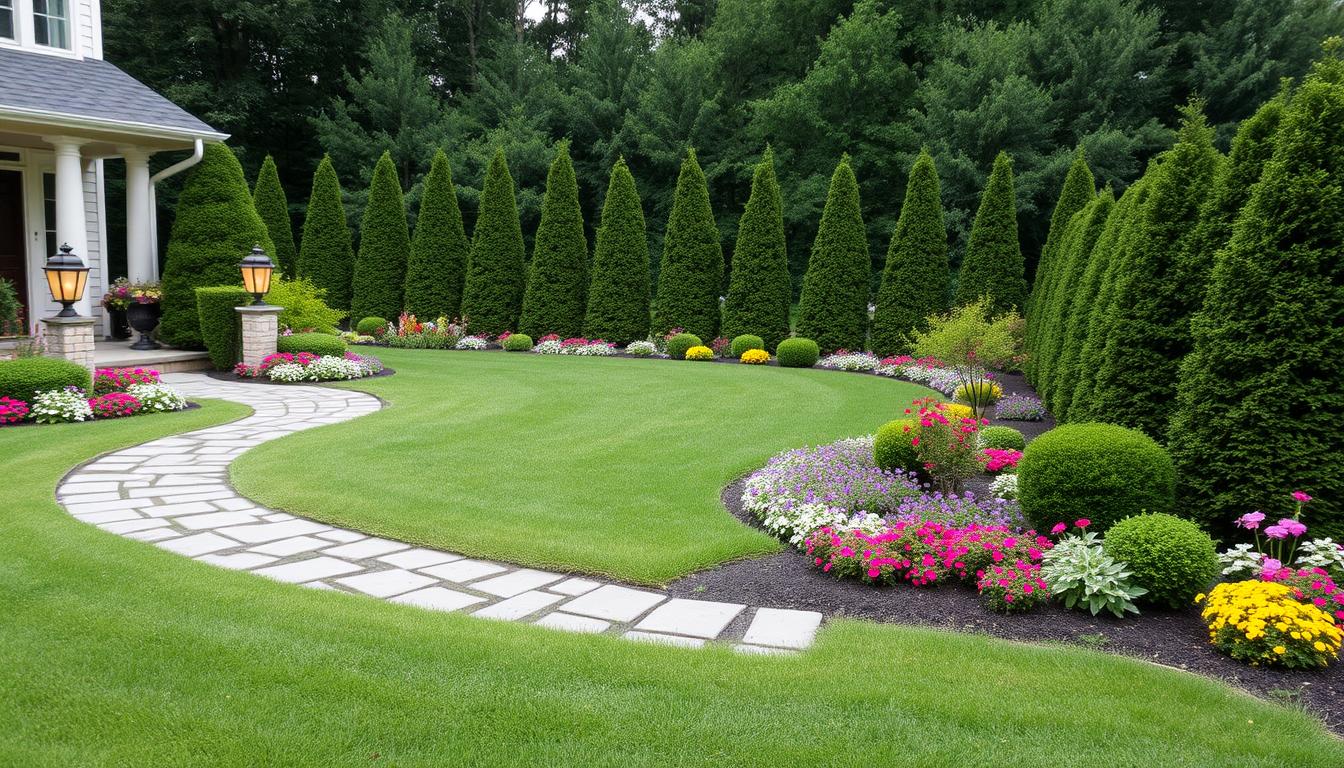First impressions matter, especially when it comes to your home. A well-designed yard not only boosts curb appeal but also increases property value. Whether you’re looking to sell or simply want to enjoy a beautiful space, strategic landscaping can make all the difference.
From evergreen elements that provide year-round beauty to low-maintenance options for busy homeowners, there’s a solution for every style and climate. Stores like Lowe’s offer regional plant selections to help you get started. Balancing aesthetics with functionality ensures your space is both stunning and practical.
Ready to transform your yard? Explore 17 actionable ideas to create a welcoming and stylish exterior that reflects your personality and enhances your home’s overall appeal.
Key Takeaways
- First impressions significantly impact home design and value.
- Strategic landscaping enhances curb appeal and property worth.
- Evergreen elements ensure year-round beauty.
- Low-maintenance options cater to busy homeowners.
- Regional plant selections, like those from Lowe’s, simplify planning.
Understanding the Basics of Front Yard Landscaping
Effective landscaping starts with understanding the basics of design and plant selection. A well-planned yard not only looks great but also thrives in your specific environment. By focusing on key principles and choosing the right plants, you can create a space that’s both beautiful and functional.
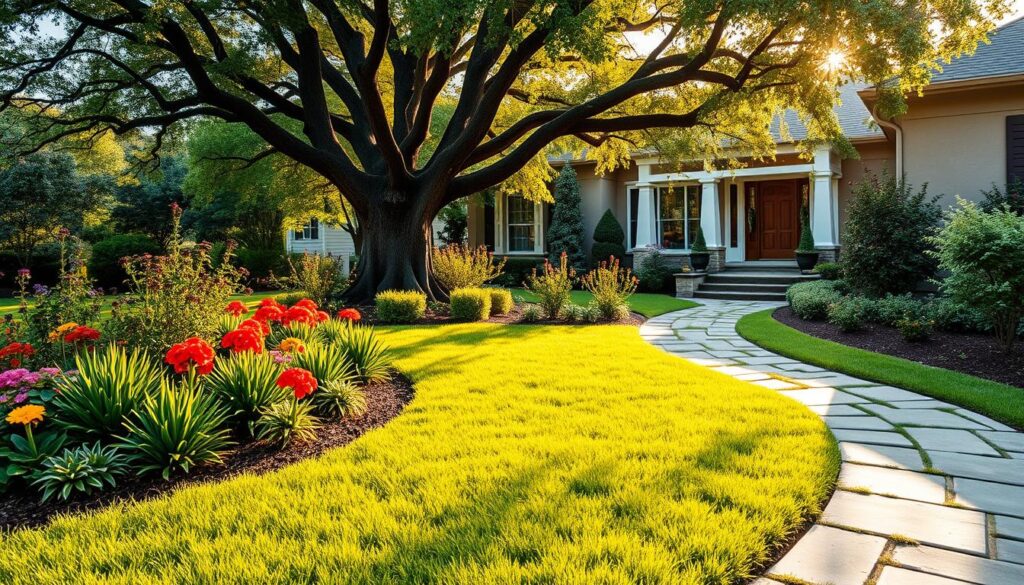
Key Design Principles for a Cohesive Look
Creating a cohesive yard involves four core principles: unity, proportion, balance, and variety. Unity is achieved by repeating shapes or colors throughout the space. Proportion ensures plants and features are scaled appropriately to your home’s size.
Balance can be symmetrical or asymmetrical, depending on your style. Variety adds interest by mixing textures, heights, and colors. Applying these principles ensures your yard feels harmonious and well-thought-out.
Choosing the Right Plants for Your Climate
Selecting plants that thrive in your climate is essential for a healthy yard. Start by checking your USDA hardiness zone to understand what grows best in your area. Local nurseries and stores like Lowe’s offer regional plant selections tailored to your environment.
Combine evergreen and deciduous plants for year-round interest. Annuals and perennials provide seasonal flexibility. Don’t forget to test your soil to ensure it supports your chosen plants.
| Design Principle | Application |
|---|---|
| Unity | Repeat shapes or colors for consistency. |
| Proportion | Scale plants to match your home’s size. |
| Balance | Use symmetrical or asymmetrical layouts. |
| Variety | Mix textures, heights, and colors for interest. |
By mastering these basics, you’ll create a yard that’s not only visually appealing but also tailored to your specific needs and environment.
Start with a Well-Maintained Lawn
A lush, green lawn is the foundation of any stunning yard. It not only enhances the overall appearance but also creates a welcoming atmosphere. Proper care and the right grass type are essential for maintaining its beauty and health.
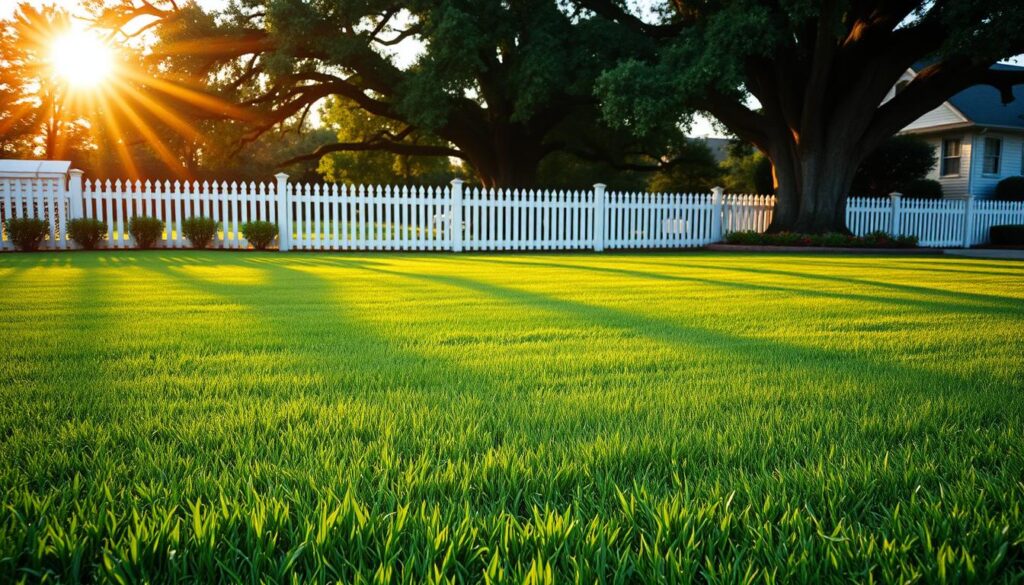
Tips for Proper Lawn Care and Maintenance
Keeping your lawn in top shape requires consistent effort. Watering is crucial—aim for 1-1.5 inches weekly to keep the soil hydrated. Mowing at the right height, typically 2-3 inches, promotes healthy growth and prevents stress on the grass.
Seasonal fertilization schedules ensure your lawn gets the nutrients it needs. Proper edging techniques create crisp lines, while dethatching and aeration improve soil health. Combat weeds naturally to avoid chemical damage, and consider grasscycling to recycle clippings as mulch.
Choosing the Right Grass for Your Region
Selecting the right grass for your climate is key to a thriving lawn. Cool-season grasses like Fescue thrive in northern regions, while warm-season varieties like Bermuda and Zoysia are better suited for southern areas. Drought-resistant turf alternatives are ideal for water-scarce regions.
Here’s a quick guide to popular grass types:
| Grass Type | Best For | Key Features |
|---|---|---|
| Bermuda | Southern regions | Drought-tolerant, heat-resistant |
| Fescue | Northern regions | Cool-season, shade-tolerant |
| Zoysia | Transition zones | Dense, low-maintenance |
By understanding your region’s needs and following these tips, you can create a lawn that’s both beautiful and resilient.
Incorporate Flower Beds for Color and Texture
Adding vibrant flower beds can instantly transform your yard into a colorful oasis. They bring life, texture, and personality to your outdoor space. Whether you prefer bold blooms or subtle foliage, the right combination can create a stunning visual impact.
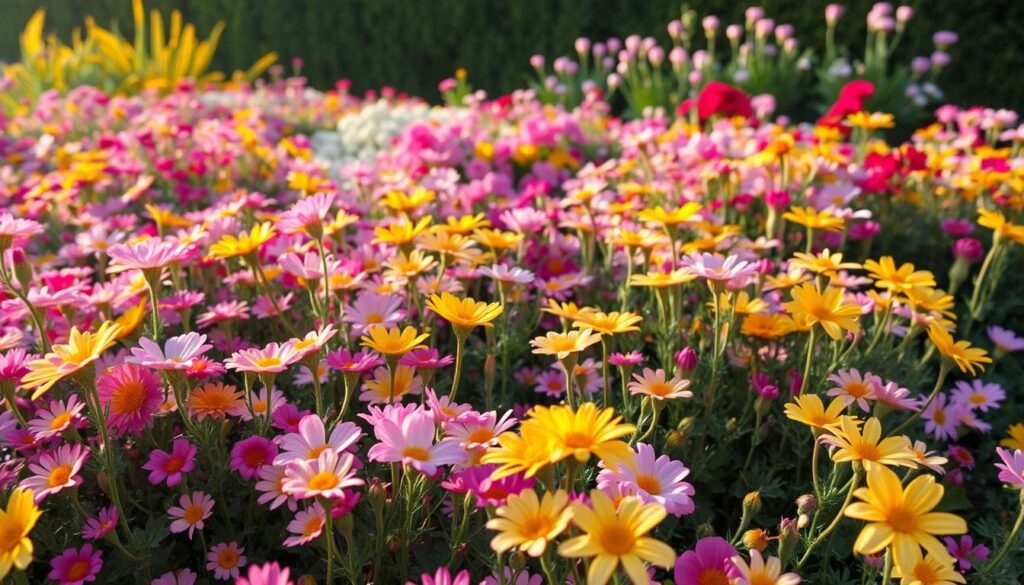
Selecting the Best Flowers for Your Yard
Choosing the right flowers is key to a thriving garden. Start by considering your climate and soil type. Opt for a mix of annuals and perennials to ensure continuous blooms throughout the year. Companion planting, like pairing marigolds with tomatoes, can also enhance growth and deter pests.
Use the color wheel to coordinate hues for a harmonious look. For example, pair purple salvia with yellow coreopsis for a striking contrast. Don’t forget to include foliage plants like hostas or ferns to add texture and depth.
Arranging Plants for Maximum Visual Impact
Proper arrangement ensures your garden looks balanced and cohesive. Place taller plants like delphiniums or sunflowers at the back, and shorter varieties like pansies or alyssum at the front. This layering technique creates depth and makes every plant visible.
Incorporate border plants like mondo grass or sweet woodruff to define edges. Use specimen plants, such as a flowering dogwood, as a focal point. Succession planting, where you rotate plants seasonally, keeps your garden vibrant year-round.
“A well-designed flower bed is like a painting—every plant plays a role in the masterpiece.”
By carefully selecting and arranging your plants, you can create a yard that’s not only beautiful but also functional. Experiment with different combinations to find what works best for your space.
Add Evergreen Shrubs for Year-Round Appeal
Evergreen shrubs are a timeless addition to any outdoor space. They provide structure, color, and texture throughout the year, making them a versatile choice for your yard. Whether you’re looking to create a formal hedge or add depth to your garden, these plants are a reliable option.
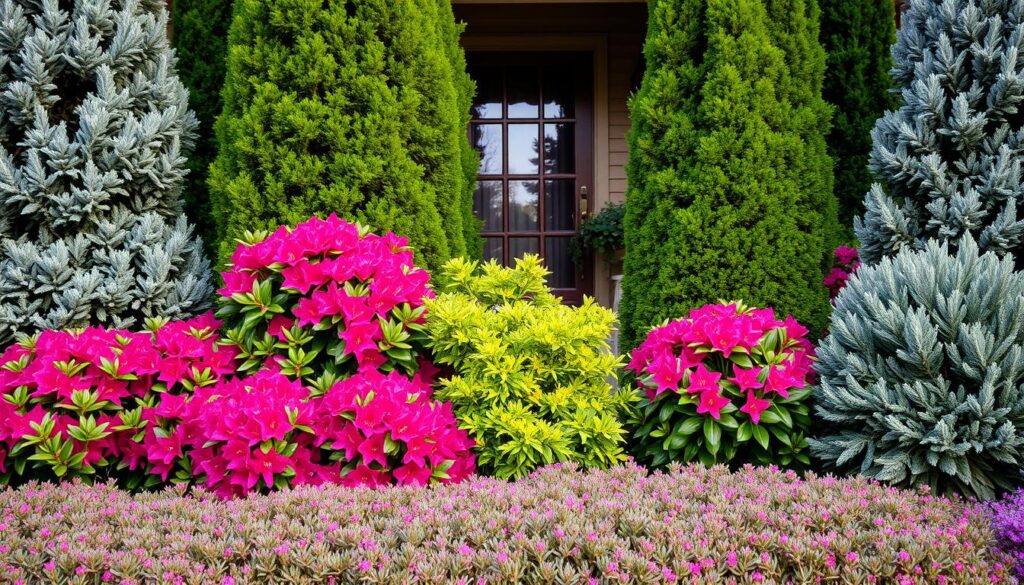
Best Evergreen Varieties for Front Yards
Choosing the right shrubs depends on your needs and climate. Dwarf varieties like boxwood or Japanese holly are perfect for smaller spaces. For disease-resistant options, consider Knockout roses or viburnum. These plants are not only hardy but also add a pop of color during bloom cycles.
Deer-resistant options, such as juniper or inkberry, are ideal for areas with wildlife. Combining needle-leaf and broadleaf textures creates visual interest. Here’s a quick guide to popular evergreen shrubs:
| Shrub | Best For | Key Features |
|---|---|---|
| Boxwood | Formal hedges | Dense, easy to shape |
| Knockout Roses | Disease resistance | Long bloom cycles |
| Juniper | Deer resistance | Low-maintenance, hardy |
Pruning and Maintenance Tips
Proper care ensures your shrubs thrive. Prune in late winter or early spring to encourage healthy growth. Always use clean, sharp tools to avoid damaging the plant. Test your soil’s pH to ensure it meets the needs of your chosen shrubs.
For container-grown plants, ensure proper drainage and regular watering. In-ground shrubs benefit from mulching to retain moisture. Regular maintenance, like removing dead branches, keeps your yard looking neat and vibrant.
“Evergreen shrubs are the backbone of a well-designed yard, offering beauty and structure in every season.”
By selecting the right varieties and following these tips, you can enjoy a lush, green space that stays stunning all year long.
Create a Focal Point with a Statement Tree
A statement tree can transform your yard into a standout space. Trees are more than just plants—they’re living art that adds structure, shade, and beauty. Whether you choose a flowering specimen or one with striking foliage, the right tree can become the focal point of your outdoor design.
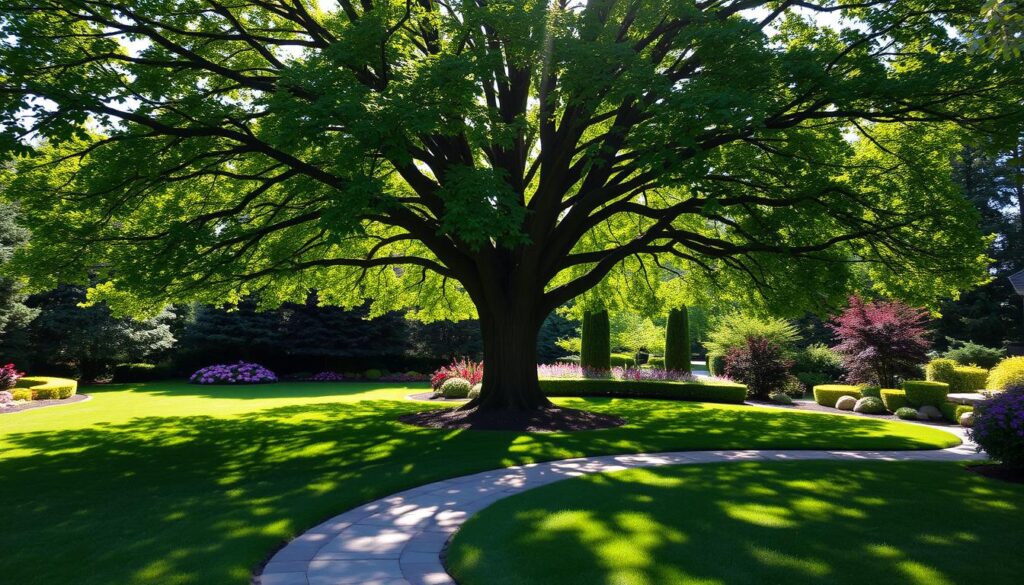
Choosing the Right Tree for Your Space
Selecting the perfect tree depends on your yard’s size and style. Consider the canopy size to ensure it fits your space without overwhelming it. Flowering trees like Kousa dogwood or redbud add seasonal color, while foliage specimens like Japanese maple provide year-round interest.
Pay attention to the root system to avoid damage to nearby structures. Plant trees 30-50 feet away from your home for safety. Here’s a quick guide to popular statement trees:
| Tree | Best For | Key Features |
|---|---|---|
| Kousa Dogwood | Small to medium yards | Flowers in spring, vibrant fall foliage |
| Redbud | Compact spaces | Pink blooms in early spring |
| Japanese Maple | Year-round interest | Striking foliage, slow-growing |
Planting and Caring for Your Tree
Proper planting ensures your tree thrives. Dig a hole twice as wide as the root ball but no deeper. Use proper staking techniques to support young trees without restricting growth. Mulch around the base to retain moisture, but avoid piling it against the trunk.
Regular pruning keeps your tree healthy and maintains its shape. Monitor for pests and diseases, and take preventive measures when needed. Water deeply during dry spells, especially in the first few years.
“A well-chosen tree is an investment in your yard’s beauty and value.”
By selecting the right tree and providing proper care, you can create a stunning focal point that enhances your outdoor space for years to come.
Use Hardscaping to Define Your Space
Hardscaping is a powerful way to shape and define your outdoor areas. From walkways to patios, these elements add structure and functionality while enhancing the overall design. Whether you’re working with a small yard or a sprawling property, thoughtful hardscaping can make a significant impact.
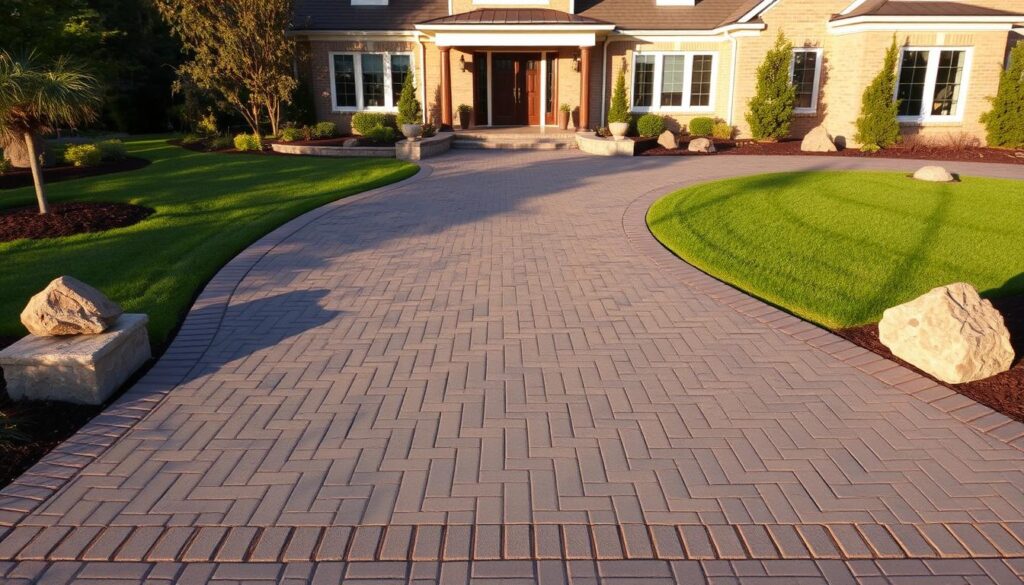
Incorporating Walkways and Patios
Walkways and patios are essential components of hardscaping. They guide movement and create distinct zones in your yard. A well-designed walkway can lead visitors to your front door or connect different areas of your garden.
Patios provide a functional space for outdoor dining or relaxation. Consider using pea gravel and stepping stones for a natural look, or opt for ipe wood for a sleek, modern feel. Permeable paving is an eco-friendly choice that reduces water runoff and supports soil health.
- Use edging stones to define pathways and prevent erosion.
- Scale designs to fit small yards without overwhelming the space.
- Integrate lighting for safety and ambiance after dark.
Choosing Materials for Durability and Style
Selecting the right materials ensures your hardscaping lasts for years. Composite decking is a low-maintenance option that resists weathering and fading. For a budget-friendly alternative, consider concrete pavers in modern or traditional styles.
Coordinate materials with your home’s architecture for a cohesive look. Terraces can manage slopes while adding visual interest. Here’s a quick comparison of popular hardscaping materials:
| Material | Best For | Key Features |
|---|---|---|
| Ipe Wood | Modern patios | Durable, weather-resistant |
| Composite Decking | Low-maintenance spaces | Eco-friendly, long-lasting |
| Pea Gravel | Natural pathways | Budget-friendly, easy to install |
“Hardscaping is the foundation of a functional and beautiful outdoor space.”
By carefully planning and selecting the right elements, you can create a yard that’s both practical and visually stunning. Hardscaping transforms your outdoor areas into inviting and well-defined spaces.
Front of House Landscape Ideas for Small Yards
Small yards offer unique opportunities for creative and efficient design solutions. With thoughtful planning, you can maximize every inch of your outdoor area, turning it into a functional and stylish retreat. Whether you’re working with a cozy patio or a narrow strip of land, these ideas will help you make the most of your space.
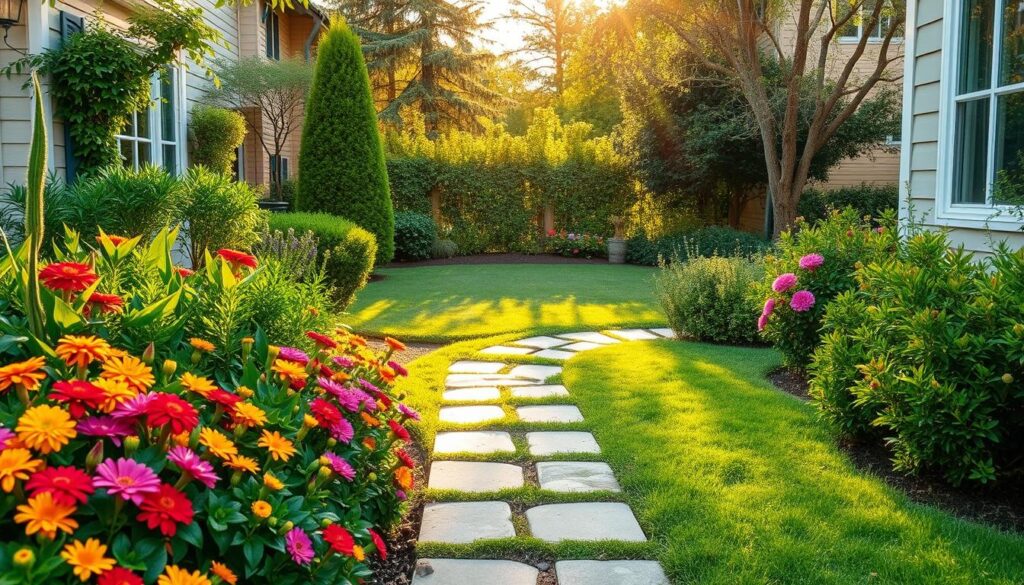
Maximizing Space with Vertical Gardening
Vertical gardening is a game-changer for compact areas. By growing plants upward, you save valuable ground space while adding visual interest. Espalier fruit tree techniques, for example, allow you to train trees against walls or fences, creating a living art piece. Hanging basket arrangements are another great option, especially for flowers or herbs.
Mirrors strategically placed can create an illusion of depth, making your yard feel larger. Dwarf plant varieties are perfect for vertical setups, as they take up less room while still providing lush greenery. Multipurpose features, like bench and planter combos, add functionality without cluttering the area.
Using Containers for Flexibility and Style
Containers are a versatile solution for small yards. They allow you to move plants around, experiment with layouts, and adapt to changing seasons. Tiered pot arrangements create height and dimension, while window box watering systems ensure your plants stay hydrated with minimal effort.
Color blocking strategies can make a big impact in a small space. Grouping plants with similar hues creates a cohesive look. Seasonal container rotations keep your yard fresh and vibrant throughout the year. Fold-down furniture solutions are perfect for maximizing functionality without sacrificing style.
“In small yards, every detail counts. Thoughtful design can transform even the tiniest space into a beautiful oasis.”
By embracing vertical gardening and container solutions, you can create a stunning outdoor area that feels both spacious and inviting. These ideas prove that even the smallest yards can pack a big punch.
Designing a Drought-Tolerant Front Yard
Creating a drought-tolerant yard is both eco-friendly and visually appealing. With water conservation becoming increasingly important, designing a space that thrives in dry conditions is a smart choice. By incorporating drought-resistant plants and strategic hardscaping, you can achieve a stunning look while reducing water usage.
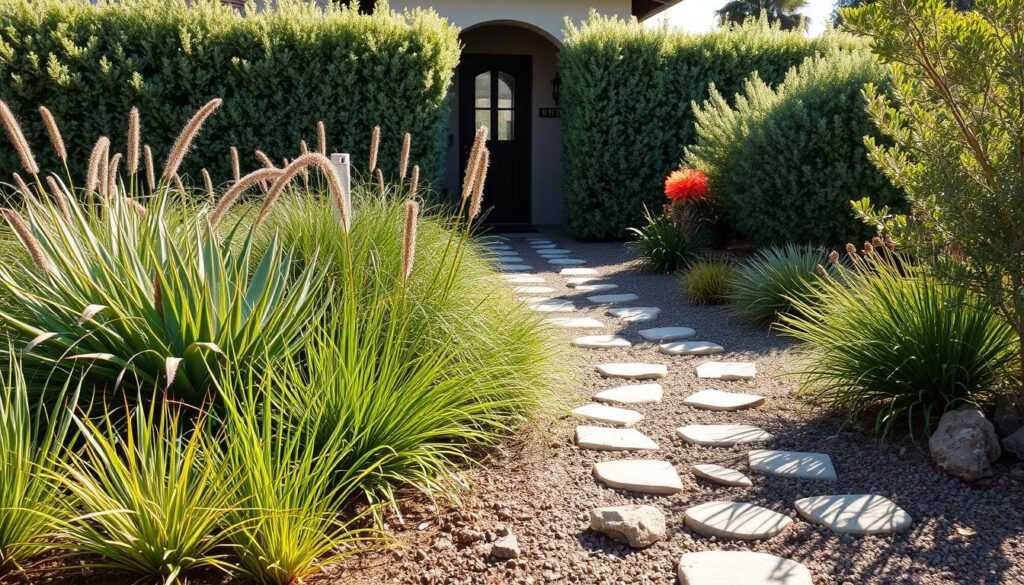
Selecting Drought-Resistant Plants
Choosing the right plants is key to a successful drought-tolerant design. Opt for species like sedum, thyme, and Russian sage, which require minimal water and thrive in arid conditions. Native plants are an excellent choice, as they’re naturally adapted to your region’s climate.
Group plants with similar water needs together to optimize irrigation. This practice, known as zone planting, ensures efficient water use. Here’s a quick guide to popular drought-resistant options:
| Plant | Key Features |
|---|---|
| Sedum | Low-maintenance, thrives in poor soil |
| Thyme | Drought-tolerant, aromatic foliage |
| Russian Sage | Tall, purple blooms, heat-resistant |
Incorporating Gravel and Rock Features
Hardscaping elements like gravel and rock features add texture and reduce the need for water-intensive lawns. Use gravel pathways to create a natural look, or install rock gardens for a low-maintenance focal point. These materials also help with erosion control, especially on slopes.
Mulching with gravel or stones retains soil moisture and suppresses weeds. Pair these features with succulents or cacti for a cohesive, water-efficient design. Drip irrigation systems can further enhance efficiency by delivering water directly to plant roots.
“A well-designed drought-tolerant yard is a testament to both beauty and sustainability.”
By combining the right plants with thoughtful hardscaping, you can create a yard that’s both stunning and water-wise. Embrace these ideas to transform your outdoor space into a sustainable oasis.
Add a Water Feature for a Tranquil Touch
Transform your outdoor space with the soothing presence of a water feature. Whether it’s a bubbling fountain or a serene pond, these elements add a sense of calm and beauty to your yard. They also attract wildlife, creating a dynamic and lively environment.
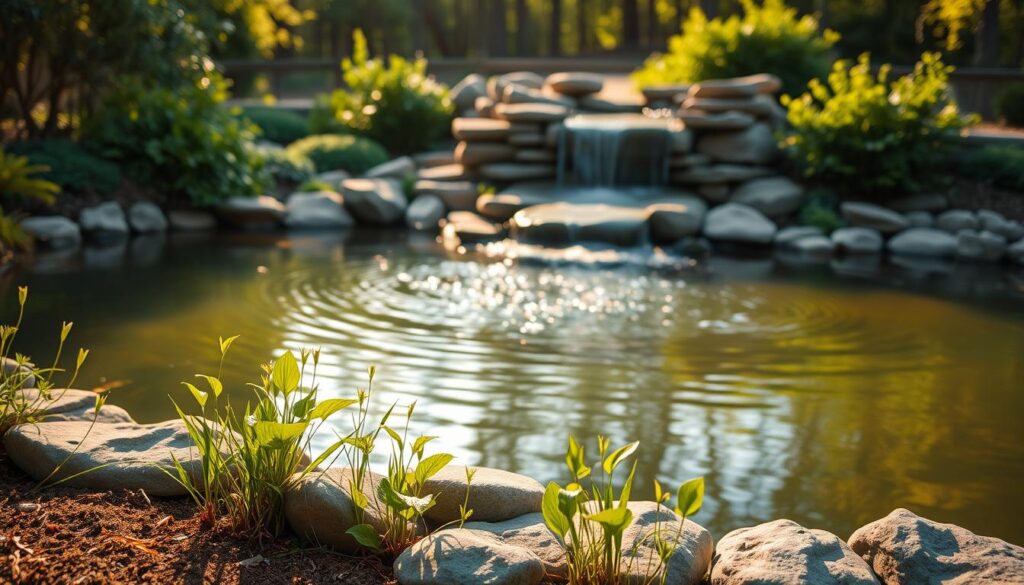
Choosing the Right Water Feature for Your Yard
Selecting the perfect water feature depends on your space and style. For smaller areas, a birdbath or tabletop fountain works well. Larger spaces can accommodate ponds or cascading waterfalls. Consider the following factors:
- Pond sizing: Ensure the pond is proportional to your yard. A 6×8 foot pond is ideal for medium-sized spaces.
- Fountain pump: Choose a pump with the right flow rate for your feature. A 500 GPH pump suits most small fountains.
- Recirculating systems: Opt for systems that conserve water and reduce maintenance.
Natural styles blend seamlessly with gardens, while formal designs add a polished look. Incorporate aquatic plants like water lilies for added beauty.
Maintenance Tips for Water Features
Keeping your water feature in top condition requires regular care. Here are some essential tips:
- Mosquito prevention: Use mosquito dunks or add fish to your pond to control larvae.
- Winterization: Drain and cover fountains during freezing temperatures to prevent damage.
- Lighting integration: Add underwater lights for nighttime ambiance and safety.
Regular cleaning and pump checks ensure smooth operation. Seasonal adjustments, like removing debris in fall, keep your feature looking its best.
“A well-maintained water feature is a source of joy and tranquility, enhancing your outdoor space year-round.”
By selecting the right feature and following these tips, you can create a peaceful retreat that adds value and charm to your yard.
Enhance Your Front Door with Potted Plants
Your front door is the gateway to your home, and potted plants can make it unforgettable. These versatile additions bring color, texture, and personality to your entryway. Whether you’re aiming for a formal look or a cozy vibe, the right plants and arrangements can elevate your curb appeal instantly.
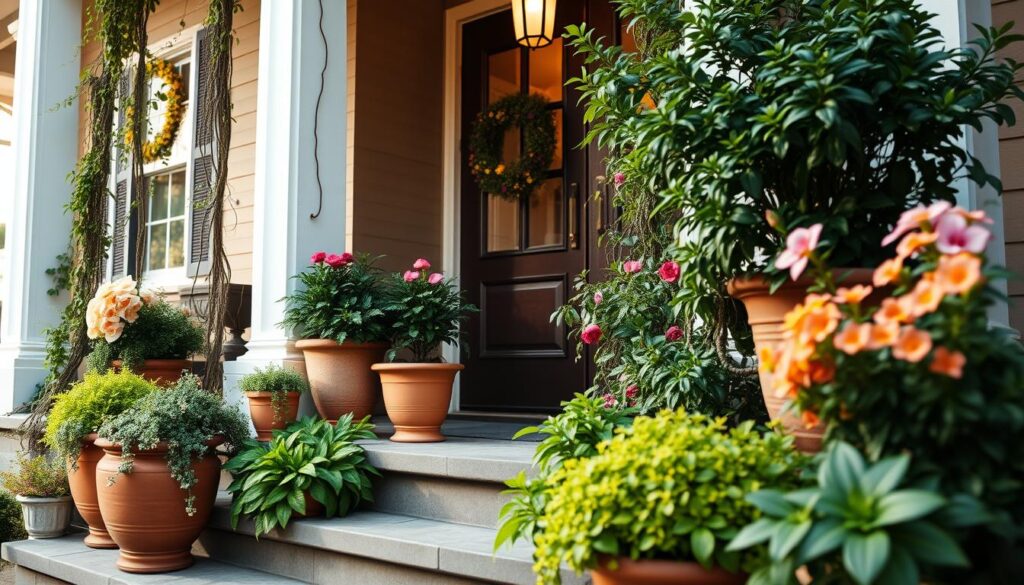
Selecting the Best Plants for Containers
Choosing the right plants for your containers is crucial for a thriving display. Start with the thriller-filler-spiller formula: a tall focal plant (thriller), medium-sized fillers, and trailing plants (spillers) for balance. Seasonal plant rotations keep your entryway fresh year-round, while fragrant options like lavender or jasmine add a sensory touch.
Consider weather-resistant materials for your pots, especially in extreme climates. Self-watering containers are a game-changer for busy homeowners, ensuring your plants stay hydrated with minimal effort. Here’s a quick guide to popular container plants:
- Thrillers: Ornamental grasses, dwarf evergreens
- Fillers: Petunias, geraniums
- Spillers: Ivy, sweet potato vine
Arranging Pots for Maximum Curb Appeal
Proper arrangement ensures your front door makes a lasting impression. Follow scale and proportion guidelines: larger pots for grand entrances, smaller ones for cozy spaces. Symmetrical arrangements create a formal look, while asymmetrical setups feel more relaxed and natural.
Color coordination is key. Match your plants to your door’s hue for a cohesive design. Lighting integration, like solar-powered LED lights, adds nighttime charm. Permanent displays with evergreens provide year-round structure, while seasonal flowers offer flexibility and variety.
“A well-arranged potted display is like a welcoming handshake for your home.”
By carefully selecting and arranging your containers, you can create an entryway that’s both beautiful and functional. Experiment with different combinations to find what works best for your space.
Incorporate Lighting for Nighttime Appeal
Illuminate your outdoor space with the perfect blend of function and style. Proper lighting not only enhances safety but also adds a touch of beauty to your yard after dark. From pathways to focal points, the right lighting can transform your space into a welcoming retreat.
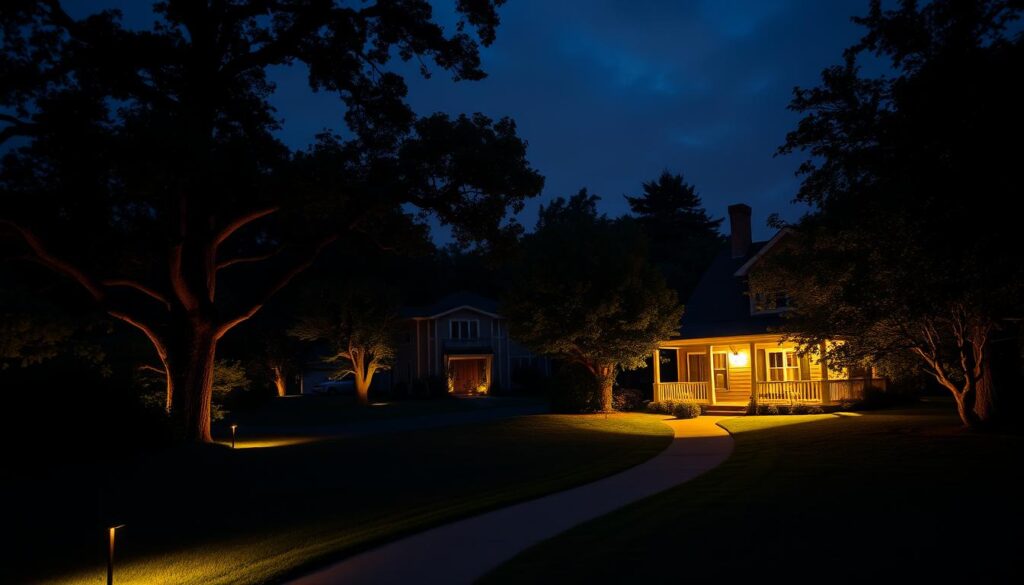
Choosing the Right Landscape Lighting
Selecting the best lighting depends on your needs and preferences. Solar-powered options are eco-friendly and easy to install, while low-voltage systems offer more control and brightness. Energy-efficient LED lights are a popular choice for their longevity and low energy consumption.
Consider uplighting techniques to highlight trees or architectural features. Pathway illumination standards ensure safe navigation, while the moonlighting effect creates a soft, natural glow. Here’s a quick comparison of lighting types:
- Solar: Eco-friendly, no wiring required
- Low-voltage: Bright, customizable, requires wiring
- LED: Energy-efficient, long-lasting
Strategically Placing Lights for Safety and Beauty
Proper placement ensures your lighting serves both practical and aesthetic purposes. Use pathway lights to guide movement and prevent accidents. Security lighting angles should deter intruders while avoiding glare for residents.
Highlight architectural features with spotlights or uplights. Dark sky compliance reduces light pollution, preserving the night sky. Timer or automation systems add convenience, ensuring your lights turn on and off at the right times.
“Well-placed lighting is the secret to a yard that’s both safe and stunning after dark.”
By choosing the right fixtures and placing them strategically, you can create a yard that’s functional, beautiful, and inviting at any hour.
Use Native Plants for Low-Maintenance Beauty
Native plants bring both elegance and sustainability to your yard. These plants are naturally adapted to your region’s climate, making them a smart choice for any outdoor space. By incorporating native species, you can create a low-maintenance landscape that thrives with minimal effort.
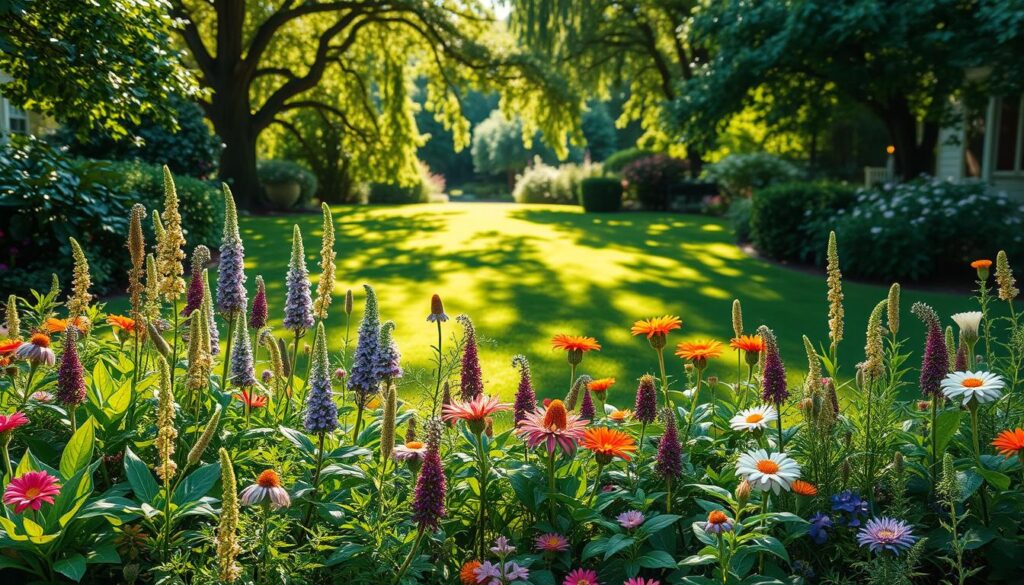
Benefits of Native Plants
Native plants offer numerous advantages for your yard. They require less water, reducing your irrigation needs and conserving resources. Their natural resistance to pests means fewer chemicals are needed, promoting a healthier environment. Additionally, these plants support local pollinators like bees and butterflies, enhancing biodiversity.
Here are some key benefits of using native plants:
- Water conservation: Native plants are adapted to local rainfall patterns, reducing the need for supplemental watering.
- Pest resistance: These plants have evolved to withstand local pests, minimizing the need for pesticides.
- Wildlife habitat: Native species provide food and shelter for birds, insects, and other wildlife.
Best Native Plants for Front Yards
Choosing the right native plants depends on your region and soil type. Coneflowers and dogwoods are excellent options for many areas. Coneflowers add vibrant color and attract pollinators, while dogwoods offer year-round interest with their flowers, foliage, and berries.
Consider these popular native plants for your yard:
| Plant | Key Features |
|---|---|
| Coneflowers | Drought-tolerant, attracts pollinators |
| Dogwoods | Year-round beauty, wildlife-friendly |
Pairing native plants with complementary species can enhance their growth and visual appeal. For example, planting milkweed alongside coneflowers creates a pollinator-friendly habitat. Seasonal interest cycles ensure your yard remains vibrant throughout the year.
“Native plants are the foundation of a sustainable and beautiful yard, offering benefits for both the environment and the homeowner.”
By selecting the right native plants and understanding their benefits, you can create a stunning, low-maintenance landscape that supports local ecosystems and enhances your outdoor space.
Create a Cottage Garden for a Charming Look
Transform your yard into a picturesque retreat with a cottage garden. This style is known for its relaxed, informal beauty and abundance of color. It’s perfect for those who want a space that feels both natural and inviting.
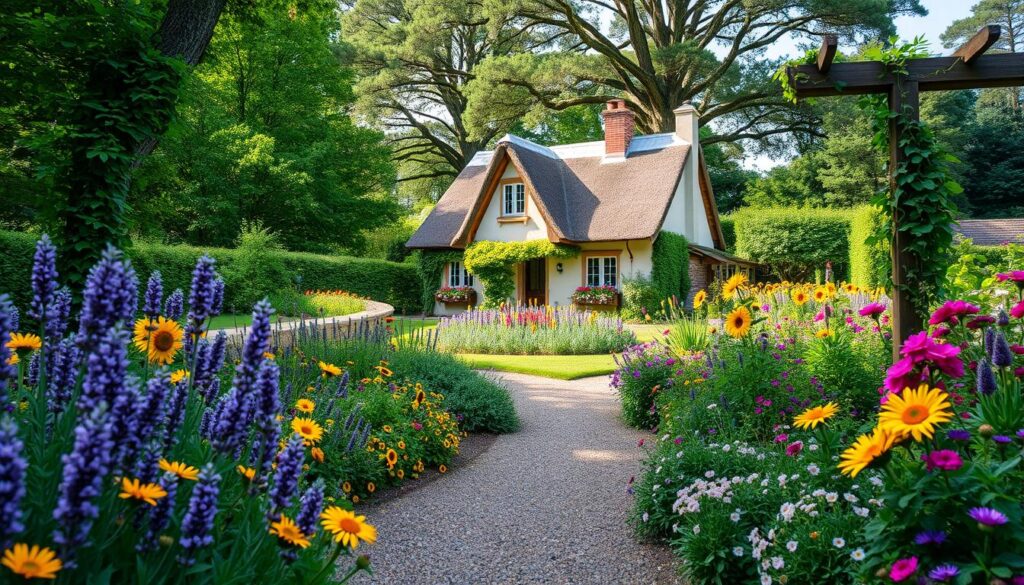
Essential Elements of a Cottage Garden
A cottage garden thrives on a mix of plants and structures that create a whimsical feel. Start with classic flowers like roses, larkspur, and hydrangeas. These plants add vibrant color and texture to your space.
Incorporate trellises or picket fences to add structure and support climbing plants. Informal plant grouping and succession planting ensure your garden looks lush throughout the year. Vintage accessories, like weathered benches or birdbaths, add a touch of charm.
- Self-seeding plants like poppies and foxgloves reduce maintenance.
- Blend warm and cool color palettes for visual harmony.
- Balance structural plants like boxwood with softer, flowing varieties.
Maintaining a Cottage Garden
Keeping your cottage garden looking its best requires regular care. Seasonal cleanup is essential to remove dead foliage and encourage new growth. Support systems, like stakes or cages, help taller plants stay upright.
Here’s a quick guide to maintaining your garden:
| Task | Frequency |
|---|---|
| Deadheading flowers | Weekly |
| Pruning shrubs | Seasonally |
| Mulching | Twice a year |
For more inspiration on creating a cozy outdoor space, check out these boho yard decor ideas.
“A well-maintained cottage garden is a living testament to nature’s beauty and resilience.”
By incorporating these elements and tips, you can create a cottage garden that’s both enchanting and easy to care for. Let your creativity flourish and enjoy the timeless appeal of this classic style.
Design a Modern Front Yard with Clean Lines
Clean lines and minimalism define the essence of contemporary outdoor design. A modern front yard combines simplicity and sophistication, creating a striking and functional space. By focusing on geometric shapes, sustainable materials, and architectural plant forms, you can achieve a sleek and stylish look that stands out.
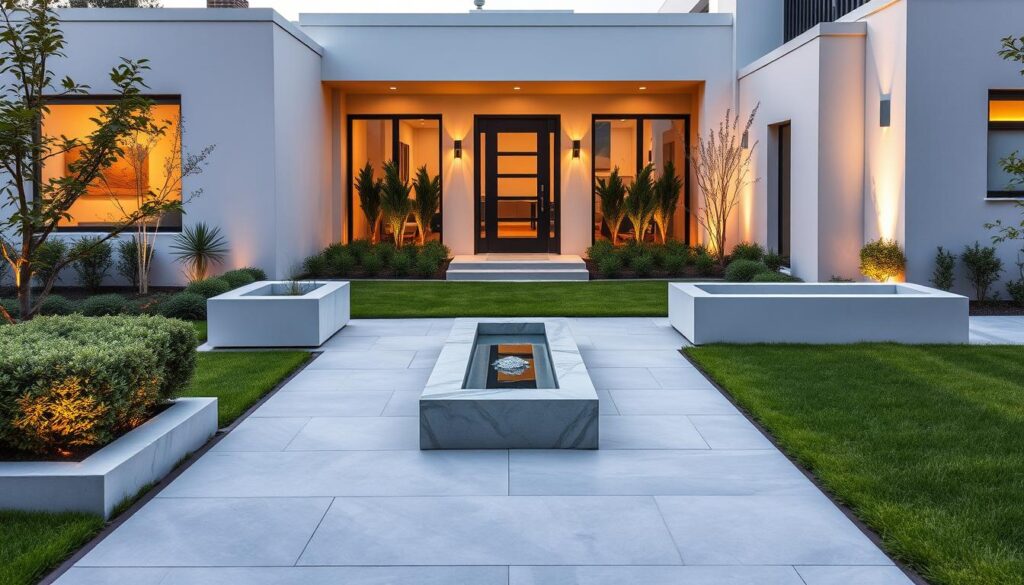
Key Features of Modern Landscaping
Modern landscaping emphasizes clean, uncluttered spaces. Geometric hardscaping, such as concrete pathways or corten steel accents, adds structure and visual interest. Monochromatic color schemes create a cohesive look, while negative space highlights key elements like water features or sculptures.
Here are some essential features of a modern yard:
- Repeating patterns for a sense of order and harmony.
- Low-profile edging to define spaces without overwhelming the design.
- Sustainable material choices like recycled concrete or corten steel.
Choosing Plants for a Modern Aesthetic
Plants play a crucial role in achieving a modern look. Opt for architectural forms like ornamental grasses, which add height and texture without clutter. Dwarf evergreens or succulents are excellent for maintaining clean lines and low maintenance.
Here’s a quick guide to selecting plants for a modern aesthetic:
| Plant | Key Features |
|---|---|
| Ornamental Grasses | Tall, airy, and low-maintenance |
| Dwarf Evergreens | Compact, year-round greenery |
| Succulents | Drought-tolerant, geometric shapes |
By incorporating these elements, you can create a modern front yard that’s both visually stunning and functional. Embrace clean lines and thoughtful design to transform your outdoor space into a contemporary retreat.
Boost Curb Appeal with Seasonal Plantings
Seasonal plantings breathe life into your outdoor space, offering year-round charm. By carefully selecting plants that thrive in different seasons, you can create a dynamic and visually appealing yard. Whether it’s the vibrant blooms of spring or the rich hues of fall, thoughtful planning ensures your space always looks its best.
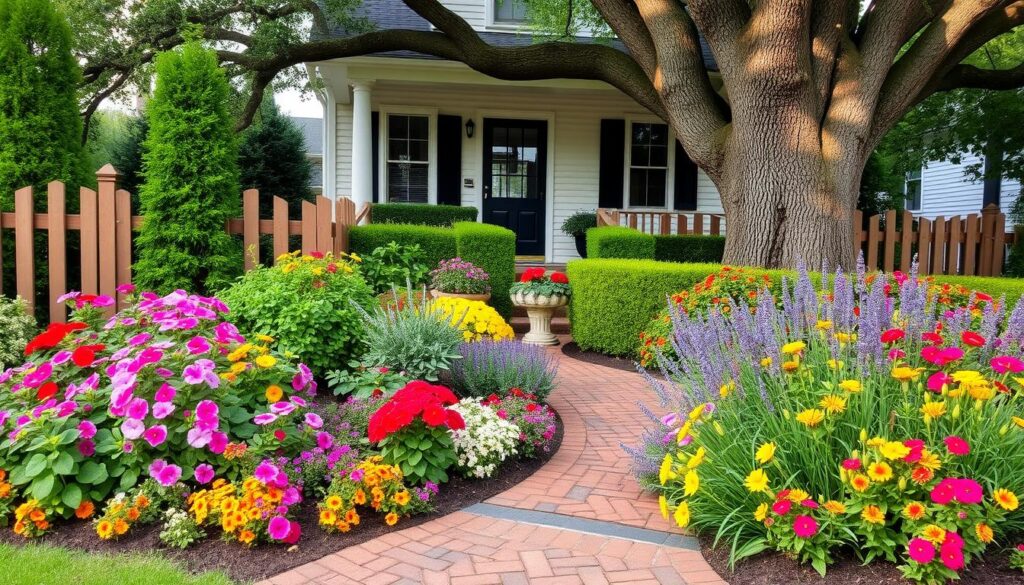
Selecting Plants for Year-Round Interest
To maintain curb appeal throughout the year, focus on a mix of plants that provide continuous interest. Evergreens serve as a reliable backbone, offering structure and color even in winter. Spring bulbs like tulips and daffodils add early bursts of color, while summer perennials like coneflowers and black-eyed Susans keep the yard lively.
For fall, consider plants with striking foliage, such as maples or burning bushes. Winter interest can be achieved with plants like holly or ornamental grasses that retain their shape and texture. Here’s a quick guide to plants for each season:
| Season | Plants |
|---|---|
| Spring | Tulips, Daffodils, Forsythia |
| Summer | Coneflowers, Black-eyed Susans, Hydrangeas |
| Fall | Maples, Burning Bushes, Sedum |
| Winter | Holly, Ornamental Grasses, Boxwood |
Rotating Annuals for Seasonal Color
Annuals are a fantastic way to introduce seasonal color and flexibility to your yard. Unlike perennials, annuals complete their life cycle in one season, allowing you to refresh your space regularly. In spring, opt for pansies or petunias. Summer favorites include marigolds and zinnias, while chrysanthemums shine in fall.
Container plant rotations make it easy to switch out annuals as the seasons change. This approach keeps your yard vibrant and adaptable. Pair annuals with perennials for a balanced look that evolves throughout the year.
“Seasonal plantings are the secret to a yard that’s always fresh, vibrant, and inviting.”
By incorporating these strategies, you can create a yard that’s not only beautiful but also reflects the changing seasons. Embrace the versatility of seasonal plantings to enhance your outdoor space and curb appeal year-round.
Conclusion: Transform Your Front Yard with These Landscape Ideas
Your outdoor space deserves a thoughtful design that reflects your style and enhances your home’s charm. By incorporating these landscape ideas, you can transform your front yard into a welcoming retreat. Start with a phased approach, focusing on one area at a time to avoid overwhelm.
Consider consulting a professional for expert guidance tailored to your space. Stores like Lowe’s offer a wide range of resources to help you get started. Personalization is key—choose elements that resonate with your taste and lifestyle.
Investing in your yard not only boosts its beauty but also increases your property’s value. Share your progress with friends and neighbors to inspire others in your community. With creativity and effort, your outdoor space can become a true reflection of your home’s personality.

